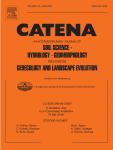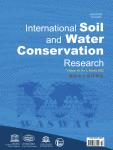
You are here
Publications in Journals
Peer review Papers published in International Journals and Magazines. As publications, we present articles published in peer-review journals indexed in Scopus or Web of Science.
Publications in Journals include more than 390 published papers from the Soil Group in the JRC (EU Soil Observatory). Most of the papers refer to the last 10 years (2013-2023). In many cases the papers document the datasets published in ESDAC.
As example statistics, Since the establishement of the EUSO, the group published:
- 23 papers in 2020,
- 27 papers in 2021
- 40 papers in 2022
- 46 papers in 2023
An important number of papers has been published in high impact factor journals: Nature, Nature Climate Change, Nature Communications, Science Advances, Science, PNAS, Global Change Biology, Science of the Total Environment, etc.
The publications are relevant to soil themes, functions and threats. The datasets generated during and/or analysed during most of the presented studies are available in the ESDAC datasets section. Almost all the publications are Open Access.
You can browse in the publications by year and you can download them (A hyperlink is provided per each publication).
Filters
Go Back To
All Documents

|
Soil priorities in the European Union |
|
|
Resource Type: Documents, Publications in Journals, Maps & Documents |
Year: 2022 |
|
|
|
||
|
|
||

|
European Soil Data Centre 2.0: Soil data and knowledge in support of the EU policies |
|
|
Resource Type: Documents, Publications in Journals, Maps & Documents |
Year: 2022 |
|
|
|
||
|
|
||

|
Phosphorus plant removal from European agricultural land |
|
|
Resource Type: Documents, Publications in Journals, Maps & Documents |
Year: 2022 |
|
|
|
||
|
|
||

|
Global rainfall erosivity projections for 2050 and 2070 |
|
|
Resource Type: Documents, Publications in Journals, Maps & Documents |
Year: 2022 |
|
|
|
||
|
|
||

|
In defence of soil biodiversity: Towards an inclusive protection in the European Union |
|
|
Resource Type: Documents, Publications in Journals, Maps & Documents |
Year: 2022 |
|
|
|
||
|
|
||

|
LUCAS Soil Biodiversity and LUCAS Soil Pesticides, new tools for research and policy development |
|
|
Resource Type: Documents, Publications in Journals, Maps & Documents |
Year: 2022 |
|
|
|
||
|
|
||
|
|
Challenges in the Geo-Processing of Big Soil Spatial Data |
|
|
Resource Type: Documents, Publications in Journals, Maps & Documents |
Year: 2022 |
|
|
|
||
|
|
||
|
|
Global assessment of storm disaster-prone areas |
|
|
Resource Type: Documents, Publications in Journals, Maps & Documents |
Year: 2022 |
|
|
|
||
|
|
||
|
|
GloSEM: High-resolution global estimates of present and future soil displacement in croplands by water erosion |
|
|
Resource Type: Documents, Publications in Journals, Maps & Documents |
Year: 2022 |
|
|
|
||
|
|
||

|
Global analysis of cover management and support practice factors that control soil erosion and conservation |
|
|
Resource Type: Documents, Publications in Journals, Maps & Documents |
Year: 2022 |
|
|
|
||
|
|
||

|
Simulating event-scale rainfall erosivity across European climatic regions |
|
|
Resource Type: Documents, Publications in Journals, Maps & Documents |
Year: 2022 |
|
|
|
||
|
|
||

|
A new high resolution object-oriented approach to define the spatiotemporal dynamics of the cover-management factor in soil erosion modelling |
|
|
Resource Type: Documents, Publications in Journals, Maps & Documents |
Year: 2022 |
|
|
|
||
|
|
||
|
|
Matrix representation of lateral soil movements: scaling and calibrating CE-DYNAM (v2) at a continental level |
|
|
Resource Type: Documents, Publications in Journals, Maps & Documents |
Year: 2022 |
|
|
|
||
|
|
||

|
Occurrence and erosion susceptibility of German Pelosols and international equivalents |
|
|
Resource Type: Documents, Publications in Journals, Maps & Documents |
Year: 2022 |
|
|
|
||
|
|
||

|
Exploring the possible role of satellite-based rainfall data in estimating inter-and intra-annual global rainfall erosivity |
|
|
Resource Type: Documents, Publications in Journals, Maps & Documents |
Year: 2022 |
|
|
|
||
|
|
||

|
Estimation of rainfall erosivity factor in Italy and Switzerland using Bayesian optimization based machine learning models |
|
|
Resource Type: Documents, Publications in Journals, Maps & Documents |
Year: 2022 |
|
|
|
||
|
|
||

|
Monitoring gully erosion in the European Union: A novel approach based on the Land Use/Cover Area frame survey (LUCAS) |
|
|
Resource Type: Documents, Publications in Journals, Maps & Documents |
Year: 2022 |
|
|
|
||
|
|
||

|
Agricultural Adaptation to Climate Change |
|
|
Resource Type: Maps & Documents, Documents, Publications in Journals |
Year: 2022 |
|
|
|
||
|
|
||
|
|
Soil Erosion in Europe: From Policy Developments to Models, Indicators and New Research Challenges |
|
|
Resource Type: Documents, Publications in Journals, Maps & Documents |
Year: 2022 |
|
|
|
||
|
|
||
|
|
Probabilistic Land Use Allocation in the Global Soil Erosion Modelling |
|
|
Resource Type: Documents, Publications in Journals, Maps & Documents |
Year: 2022 |
|
|
|
||
|
|
||

|
Soil organic carbon under conservation agriculture in Mediterranean and humid subtropical climates: Global meta-analysis |
|
|
Resource Type: Documents, Publications in Journals, Maps & Documents |
Year: 2022 |
|
|
|
||
|
|
||
|
|
Predictive Mapping of Electrical Conductivity and Assessment of Soil Salinity in a Western Türkiye Alluvial Plain |
|
|
Resource Type: Documents, Publications in Journals, Maps & Documents |
Year: 2022 |
|
|
|
||
|
|
||

|
Machine learning modelling framework for Triticum turgidum subsp. durum Desf yield forecasting in Italy. |
|
|
Resource Type: Maps & Documents, Documents, Publications in Journals |
Year: 2022 |
|
|
|
||
|
|
||
|
|
Outreach and Post-Publication Impact of Soil Erosion Modelling Literature |
|
|
Resource Type: Documents, Publications in Journals, Maps & Documents |
Year: 2022 |
|
|
|
||
|
|
||

|
Sustainable futures over the next decade are rooted in soil science |
|
|
Resource Type: Documents, Publications in Journals, Maps & Documents |
Year: 2022 |
|
|
|
||
|
|
||